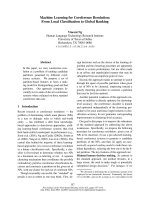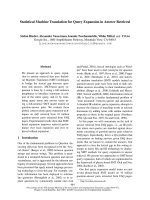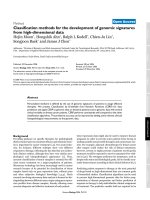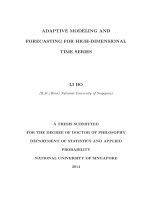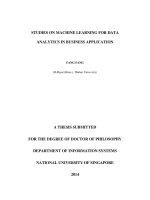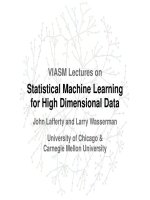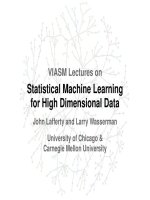Statistical Machine Learning for High Dimensional Data Lecture 2
Bạn đang xem bản rút gọn của tài liệu. Xem và tải ngay bản đầy đủ của tài liệu tại đây (2.39 MB, 64 trang )
VIASM Lectures on
Statistical Machine Learning
for High Dimensional Data
John Lafferty and Larry Wasserman
University of Chicago &
Carnegie Mellon University
Outline
1
Regression
predicting Y from X
2
Structure and Sparsity
finding and using hidden structure
3
Nonparametric Methods
using statistical models with weak assumptions
4
Latent Variable Models
making use of hidden variables
2
Lecture 2
Structure and Sparsity
Finding hidden structure in data
3
Topics
• Undirected graphical models
• High dimensional covariance matrices
• Sparse coding
4
Undirected Graphs
Let X = (X1 , . . . , Xp ). A graph G = (V , E) has vertices V , edges E.
Independence graph has one vertex for each Xj .
✗✔
✗✔
X
Y
✖✕
✖✕
✗✔
Z
✖✕
means that
X
Z
Y
V = {X , Y , Z } and E = {(X , Y ), (Y , Z )}.
5
Markov Property
A probability distribution P satisfies the global Markov property with
respect to a graph G if:
for any disjoint vertex subsets A, B, and C such that C separates A
and B,
XA XB XC .
6
Example
1
6
7
8
2
3
4
5
C = {3, 7} separates A = {1, 2} and B = {4, 8}. Hence:
C = {3, 7} separates A = {1, 2} and B = {4, 8}. Hence,
{X1 , X2 } {X4 , X8 } {X3 , X7 }.
{X1 , X2 }
{X4 , X8 }
{X3 , X7 }
7
Example
A 2-dimensional grid graph.
The blue node is independent of the red nodes given the white nodes.
8
Example: Protein networks (Maslov 2002)
9
Distributions Encoded by a Graph
• I(G) = all independence statements implied by the graph G.
• I(P) = all independence statements implied by P.
• P(G) = {P : I(G) ⊆ I(P)}.
• If P ∈ P(G) we say that P is Markov to G.
• The graph G represents the class of distributions P(G).
• Goal: Given X 1 , . . . , X n ∼ P estimate G.
10
Gaussian Case
• If X ∼ N(µ, Σ) then there is no edge between Xi and Xj if and
only if
Ωij = 0
where Ω = Σ−1 .
• Given
X 1 , . . . , X n ∼ N(µ, Σ).
• For n > p, let
Ω = Σ−1
and test
H0 : Ωij = 0 versus H1 : Ωij = 0.
11
Gaussian Case: p > n
Two approaches:
• parallel lasso (Meinshausen and Buhlmann)
¨
• graphical lasso (glasso; Banerjee et al, Hastie et al.)
Parallel Lasso:
1
For each j = 1, . . . , p (in parallel): Regress Xj on all other
variables using the lasso.
2
Put an edge between Xi and Xj if each appears in the regression
of the other.
12
Glasso (Graphical Lasso)
The glasso minimizes:
− (Ω) + λ
|Ωjk |
j=k
where
1
(log |Ω| − tr(ΩS))
2
is the Gaussian loglikelihood (maximized over µ).
(Ω) =
There is a simple blockwise gradient descent algorithm for minimizing
this function. It is very similar to the previous algorithm.
R packages: glasso and huge
13
Graphs on the S&P 500
• Data from Yahoo! Finance (finance.yahoo.com).
• Daily closing prices for 452 stocks in the S&P 500 between 2003
and 2008 (before onset of the “financial crisis”).
• Log returns Xtj = log St,j /St−1,j .
• Winsorized to trim outliers.
• In following graphs, each node is a stock, and color indicates
GICS industry.
Consumer Discretionary
Energy
Health Care
Information Technology
Telecommunications Services
Consumer Staples
Financials
Industrials
Materials
Utilities
14
S&P 500: Graphical Lasso
●
●
●
● ●●●●●●
●
●●●
●
● ●● ●
●
●
●
●
●
● ●
● ●● ●
● ●
● ●
●
●
●
●
●
●
●
●
●
●
●
●
●
●
●
●
●
●
●
●
●
●
●
●
●
●
●
●
●
●
●
●
●
●
●
●
●
● ●●
● ●
●
● ●●
●●● ●
●
●
●
●
●
● ● ●
● ●●
● ●
●●●
●
●
● ●
● ●
●
●
●
●
●
●
●
●
●
●
●
●
●
●
●
●
●
●
●
●
●
●
●
●●
● ●
● ●
●● ●●
●
●
●
●
●
●
●
●
●
●
● ●●
●
●
●
●
●
●
●
15
S&P 500: Parallel Lasso
● ●
●
●
●
●
●
●
●●
●
●● ●
● ●
●
●
● ●
● ●
●
●
●
●
●
● ●
●
●
● ●
●
●
●
● ●
●
●
●
●
● ●
●
●
●
● ●
● ● ●●
●
●● ● ●
● ●
● ●
●●●
● ● ●●
●
●
●
●
●
●
●
●
●
●
●
●
●
●
●
●
●
●
●
●
●
●● ● ●
●
●
●
●
●
●
●
●
● ●●
●
●
●
●
●●
●
●
●
●
● ●
●
●
●
●
●
●
●
● ● ●
●
●
●
● ●●
●
● ●
●
●
●
● ●
●
● ● ●
●
●
●
●
●
●
●
●
●
● ●
●
●
●
●
● ●
●
●
●
●●
●
●
●
●
●
● ● ●
●
● ●
●
●
●
●
●
●
●
●
●
●
●
●●
● ●
●
●
●
●
●
●
●
●
● ● ● ●●
● ●●
●
●
●
● ● ●
●
●
●
●
● ●
●● ●
●
●
●
●
●
●
●
●
●
● ●
●
●
● ●
●
● ●
● ●
●
● ●
● ● ●
●
●
●
●
●
● ●
●
●
●
● ● ●
●
●
●
●
● ●
● ●
●
● ● ●
●
●
●●
●
●
●
●
●
●
●
●
●
●
●
● ●
● ●
● ●
●
●
16
Example Neighborhood
Yahoo Inc. (Information Technology):
• Amazon.com Inc. (Consumer Discretionary)
• eBay Inc. (Information Technology)
• NetApp (Information Technology)
17
Example Neighborhood
Target Corp. (Consumer Discretionary):
• Big Lots, Inc. (Consumer Discretionary)
• Costco Co. (Consumer Staples)
• Family Dollar Stores (Consumer Discretionary)
• Kohl’s Corp. (Consumer Discretionary)
• Lowe’s Cos. (Consumer Discretionary)
• Macy’s Inc. (Consumer Discretionary)
• Wal-Mart Stores (Consumer Staples)
18
Parallel vs. Graphical
●
●
●
●
●
●
●
●
●
●●
●
●● ● ●
●● ●
● ●●
● ●●●
●● ● ●
●
●
●
●
●
● ●
●
●●
● ●
●
●
●
●●
●
●
●
●
●
●
●
●
●
● ●
●
●
●●
● ●●
● ●●
● ● ●
●
●
● ●
● ●
●
●
●
● ●
●
●
●
●
●
●
●
● ●
●
●
● ●
●
●
●●
●● ●
● ●
●
●
●
●
●
●
●
●
●
●
●
● ●
●●
● ●●
●●
●
●●
●
●● ● ●
●● ●
● ●●
● ●●●
●● ● ●
●
●
●
●
●
● ●
●
●
●
● ●
●
●
●
●
●
●●
● ●
●
●
●
●
●
●
●
● ●
●
●
●
●●
●
●
●
●
●
●
●
●
● ●
●
●
●
●●
● ●●
● ●●
● ● ●
●
●
● ●
● ●
●
●
●
●
●
●
●
●
●
● ●●
●
●
●
●
● ●
●
●
●
●
●
●
● ●
●
●
●
● ●
●
●
● ●
●
●
●●
●● ●
● ●
●
●
●
●
●
●
●
●
●
●●
●
●
●
●●
●
●
●
●
● ●
●●
● ●●
●
●
●
●
●
●
●
● ●
●
●
●
● ●
● ●
●
●
●
● ●
●
●
●●
●
● ●
● ● ●
●● ● ●
●
●
●
●
● ●
● ● ●●
● ● ●●
●
●
● ●●
●●
● ●
●
● ● ●● ●
●●
●
●
●
●
●
●
●
● ● ●
● ●
●
●
●
●
●
● ●
●
●
●
●
● ●
●
●
●
●
●
●
●
●
●
● ● ●
●
●
● ●
● ●
●
●
●
●
●
●
●
●
●
●
● ● ●
●
●
●
● ●
●
●
●
● ●
●
●
●
●
● ●
●
●
●
●
●
●
●
●
● ●
●
●
●●
●
●
●
●
●
●
●
●
●
●
●
●
● ●●
●
●
●
●
● ●
●
●
● ●
● ●
●
●
●
● ●
●
●●
● ●
● ●
● ●
●
●
●●
●
●
●
●
● ●
● ● ●●
● ● ●●
●
●
● ●●
●●
● ●
●
● ● ●● ●
●●
●
●
●
●
●
●
● ● ●
● ●
●
●
●
●
●
● ●
●
●
●
●
● ●
●
●
● ●
●
●
●
●
●
●
●
●
●
● ● ●
●
●
● ●
●
●
●
●
●
● ●
●
●
● ●
●
●
● ● ●
●
●
● ●
●
● ●
●
●
●
●
●
●
●
●
●
●
●
●
●
●
●
●
● ●
●
19
Choosing λ
Can use:
1
Cross-validation
2
BIC = log-likelihood - (p/2) log n
3
AIC = log-likelihood - p
where p = number of parameters.
20
Discrete Graphical Models
Let G = (V , E) be an undirected graph on m = |V | vertices
• (Hammersley, Clifford) A positive distribution p over random
variables Z1 , . . . , Zn that satisfies the Markov properties of graph
G can be represented as
p(Z ) ∝
ψc (Zc )
c∈C
where C is the set of cliques in the graph G.
21
Discrete Graphical Models
• Positive distributions can be represented by an exponential
family,
p(Z ; β ∗ ) ∝ exp
βc∗ φc (Zc )
c∈C
• Special case: Ising Model (binary Gaussian)
p(Z ; β ∗ ) ∝ exp
βi∗ Zi +
i∈V
βij∗ Zi Zj .
(i,j)∈E
Here, the set of cliques C = {V ∪ E}, and the potential functions
are {Zi , i ∈ V } ∪ {Zi Zj , (i, j) ∈ E}.
22
Graph Estimation
• Given n i.i.d. samples from an Ising distribution,
{Z s , s = 1, . . . , n}, identify underlying graph structure.
• Multiple examples are observed:
23
Local Distributions
• Consider Ising model p(Z ; β ∗ ) ∝ exp
(i,j)∈E
βij∗ Zi Zj .
• Conditioned on (z2 , . . . , zp ), variable Z1 ∈ {−1, +1} has
probability mass function given by a logistic function,
1
P(Z1 = 1 | z2 , . . . , zp ) =
1 + exp
j∈N (1)
.
∗z
β1j
j
24
Parallel Logistic Regressions
Approach of Ravikumar, Wainwright and Lafferty (Ann. Stat., 2010):
• Inspired by Meinshausen & Buhlmann
(2006) for Gaussian case
¨
• Recovering graph structure equivalent to recovering
neighborhood structure N (i) for every i ∈ V
• Strategy: perform
1 regularized logistic regression of each node
Zi on Z\i = {Zj , j = i} to estimate N (i).
• Error probability P N (i) = N (i) must decay exponentially fast.
25


